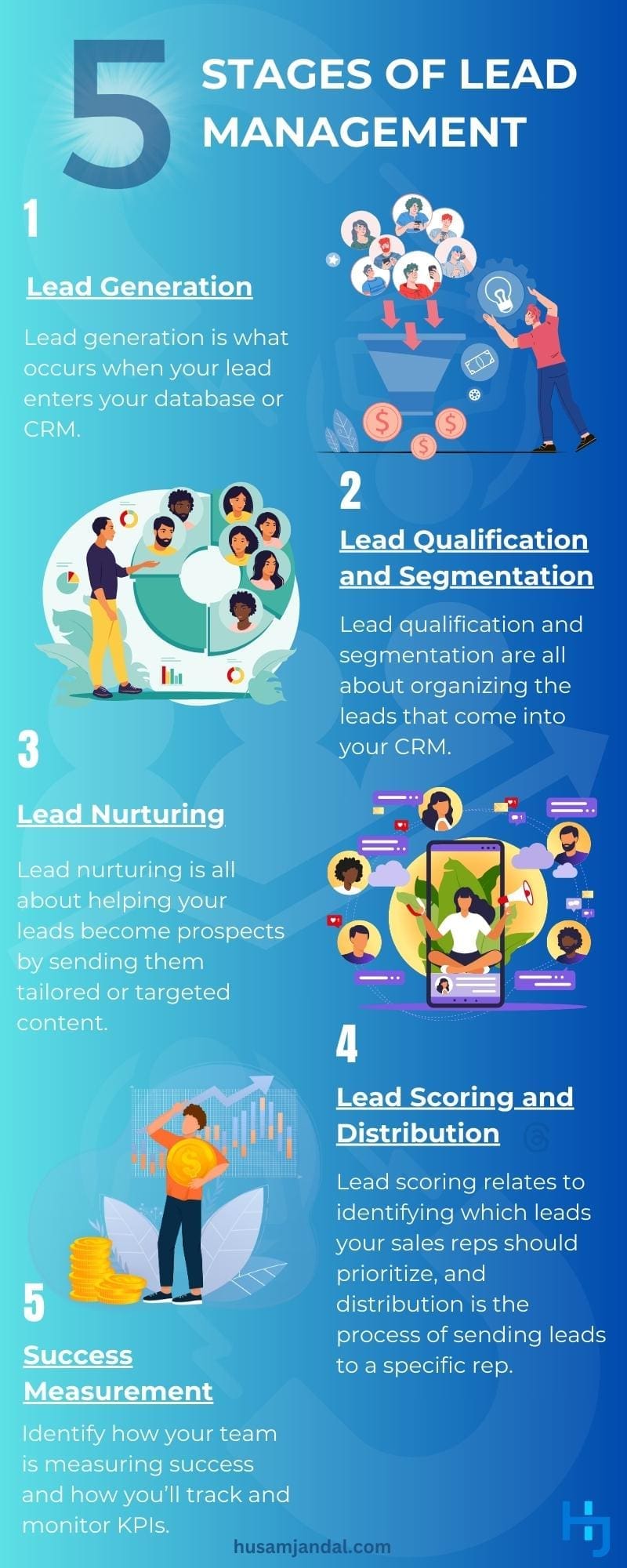
People are discovering your business online and submitting online forms. Your sales team is ready and eager to start contacting them all, but there’s just one thing… not everyone is ready to become a client right now. Some aren’t a good fit for your business, and others need more time before they’re ready. Your sales team is starting to get overwhelmed by the deluge of leads and doesn’t know who to prioritize. Sometimes leads get lost.
This is a common scenario, and it plays out every day in growing small and midsized businesses. Many small business owners try to solve the issues by increasing the size of their sales teams or at least dream of expansion when the sales revenue starts rolling in. Despite how it might seem, however, these are not people problems. In fact, adding to your headcount while you’re coping with these challenges can actually make it worse and increase wasteful spend. What you really need is a good lead management strategy to keep track of them all and streamline the sales process.
What is Lead Management?
Sales lead management, sometimes referred to as “leads management” or shortened to “lead management,” is the process of organizing, processing, and tracking contacts that may eventually become clients, also referred to as “sales leads” or “leads.”
What is the Difference: Lead Generation vs. Lead Management
Lead generation is the process of attracting prospective clients to your business. Lead management is what happens with those prospective clients once your company becomes aware of them and has their data.
Benefits of Lead Management for Your Business
Nine in ten marketers say lead generation is their most important goal, per Ruler Analytics. Brands are willing to invest considerably in the lead gen process, too. For instance, it costs a typical business services company $132 to generate a single lead, according to the Integrated Marketing Association. Yet, about a quarter of businesses don’t respond to leads at all, HBR researchers say. A further quarter takes more than 24 hours to reach out to leads. In the meantime, the probability of simply reaching the lead, let alone making a sale, diminishes.
A strong management system addresses all those issues and more. When you know how to manage leads effectively, your business will have an easier time:
- Identifying which leads are more likely to convert.
- Streamlining the sales process.
- Distributing work for faster response times and more effective service.
- Closing more deals.
- Getting top ROI from your sales and marketing efforts.
Tools to Improve Lead Management
One of the most common questions asked is: “Should you use CRM software for your lead management?” The answer is a resounding “yes.” Short for customer relationship management, CRM software makes it easy to ensure your leads don’t fall through the cracks, automates countless processes, and provides actionable insights that will help you close more sales.
A good CRM is so important that most of this page is written with the expectation that you already have one or plan to implement one as part of your strategy. I’ll go over these in more detail as we discuss the five stages of lead management, though, as a start, your team will get better results if you have the following either as part of your CRM or sourced individually:
- Lead Capture (ability to capture data provided by the lead via web forms, chatbot, live chat, etc., as well as back-end data such as where the lead came from)
- Activity Tracking (ability to see when leads visit your site, click emails, etc.)
- Lead Scoring (automatic ranking of leads based on activities)
- Lead Distribution/ Routing (automatic sending of leads to the best sales rep for their needs)
- Built-in communication (both automated emails based on the lead’s status and one-on-one messages, ideally with templates for faster sending)
- Lead Tracking (ability to see what stage a lead is in)
- Analytics and Reporting
- Interoperability (ability to connect with/ integrate with other systems your business uses now and in the future)
What Are the 5 Stages of Lead Management?
Think of your lead management as similar to the digital marketing tree. Each stage builds upon the stages before it. Whether you’re creating your CRM lead management strategy from scratch or are trying to finetune your lead management workflow, you don’t need to deploy all five stages at once. Start with the first stage and perfect it before you move forward. Ultimately, you’ll have a beautiful lead ecosystem that brings the best of operations, sales, and marketing together to increase conversions and boost ROI.
1. Lead Generation
Lead generation is what occurs when your lead enters your database or CRM. If you are starting your lead management strategy from scratch, you’ll start here. In this stage, it’s all about getting good data into your lead management system from your lead capture sources. Again, if you’re using a good CRM, leads and the data they provide will be automatically imported into your CRM as soon as the lead provides it.
If you’re refining your strategy, get answers to the questions covered below to determine if you need to improve in this area. Note that the sales department may be unable to answer these questions if the marketing team hasn’t done its part or operations haven’t equipped marketing with effective lead capture and analytics tools.
What’s your average view-to-contact conversion rate?
With this metric, view refers to the total number of times a page is seen by someone, and contact references the person who has been added to your CRM, usually as a lead. Some businesses will also use visit-to-contact, which refers to the total number of sessions in which a visitor explores the page. The metric you choose isn’t as important as choosing one and using it to measure consistently.
Every business will be a bit different here. A higher figure isn’t always better because quality usually decreases with quantity. However, you may find that certain pages always outdo others by a wide margin. For instance, if you work with referral partners and create dedicated landing pages for them, those people will come primed to work with you, and conversions will be exponentially higher. Equally, a site that isn’t optimized for conversions will usually sit at less than one percent. Improving your view-to-contact conversion rate by even one or two percent may be ideal in these situations. Benchmark against yourself here and compare different pages.
How are you generating leads?
Can you name which specific sources, campaigns, and content are producing them?
Where should you be generating more leads?
Are certain sources, campaigns, or content failing to produce leads as they should?
2. Lead Qualification and Segmentation
Lead qualification and segmentation are all about organizing the leads that come into your CRM. If you are starting your lead management strategy from scratch, this will be your second step. During this stage, you’ll break your leads or new contacts into groups based on their behavior or readiness to purchase. Your teams should work together to determine which behaviors and characteristics have meaning and what those groups should be. For instance, is age relevant to lead behavior? Industry? Job title or role?
If you’re getting good data during the lead generation and lead capture phase, and it makes its way into your CRM in a sensible way, qualification and segmentation can be completely automated too.
If you’re refining your process, the following questions can help you determine if you need to work on qualification and segmentation.
Can you tell the difference between a sales classified lead (lead), sales-qualified lead (prospect), and sales solidified lead (opportunity)?
A sales classified lead (lead) is a person who shows interest in your product or service but isn’t ready to buy yet. A lead will sometimes download top-of-funnel content (general information articles, how-to guides, listicles, etc.), subscribe to your newsletter, attend a general webinar, or connect with your business in a similar fashion. Some will never move through the sales funnel because they’re not searching for what you offer, while others may respond after further nurturing.
A sales-qualified lead (SQL or prospect) is someone who shows readiness to a purchase AND meets your qualification criteria. A prospect will sometimes download bottom-of-funnel content (case studies, product comparison guides, demos, etc.) or may request a live demo or trial.
A sales solidified lead (opportunity) is someone who is prepared to purchase, provided they’re satisfied with the offer and everything meets their requirements. This person is unique because they’ve likely asked for an estimate or proposal.
Sales reps should be reaching out to all leads as quickly as possible to build their pipeline with a healthy volume of prospects and opportunities. A fast speed-to-lead or lead response time is a crucial component of this. Knowing the stage of each lead supports this by allowing you to route and prioritize leads efficiently.
Does the sales team waste a lot of time talking to unqualified leads?
Sales classified leads are unlikely to convert without further nurturing, and unqualified leads are not likely to convert at all. So, you can often tell if your sales team is wasting time talking to unqualified leads because they’re being disqualified on the call, if they’re getting the runaround from people they’re calling, or if leads become stagnant.
Can you identify which leads are ready to enter your sales process?
Your system should be set up to recognize behavioral triggers that demonstrate someone is getting ready to make a purchase. These signals will differ by the company but often include things like downloading bottom-of-funnel content, requesting a consult, or requesting a demo.
What are your segments?
There are countless ways to segment leads. For instance, you can break them down by location, job, company, need/ concern, revenue/ income, persona, interactions with your business, and more. That way, you can personalize their journey, nudge leads to the prospect stage, and help move prospects to the opportunity stage. Your team should know how you segment your leads and why they’re segmented that way.
It’s also worth noting that your segments may be refined over time. For instance, you may start by gathering only basic data on your lead capture forms, then ask leads to provide more details as they move through your funnels. With this approach, you can maximize form fills and build up robust lead profiles over time.
Is the marketing team sending mass emails that have low engagement or result in a high number of unsubscribes?
Nine in ten consumers say they’re more likely to shop with brands that provide offers and recommendations that are relevant to them, according to Accenture. Almost half say they’ve left a website and purchased elsewhere because the content was poorly curated. The same is true of email, though you’ll see it more in terms of unsubscribes and low engagement. That means the odds of selling to a lead in the future largely hinge on your ability to customize their experience or feed them content that’s relevant to their needs. The only way you can do that is through proper segmentation.
3. Lead Nurturing
Lead nurturing is all about helping your leads become prospects by sending them tailored or targeted content. If you’re tracking your website data and already have content, you can repurpose top-performing content and send it out to specific segments. You can also look into which content performs the best and create tailored content for your leads.
If you’re refining the way you manage your leads and performing an audit to see if your lead nurturing stage needs help, ask yourself the following questions.
Are you leveraging email automation?
If your segments are mindfully crafted, and your CRM or email campaign tool provides automation, you can put a lot of your nurturing emails on autopilot. There’s no need for your marketing and sales team to manually message leads or send out mass blasts all the time. If you aren’t automating your nurturing emails, assess your current technology to see if it’s possible and build some workflows to test it out.
What are our average email open rates and click-through rates?
The average open rate is 21.5 percent, according to Campaign Monitor research. This encompasses a wide variance by industry, with retail coming in at the lowest at 17.1 percent and education topping the charts at 28.5 percent. Click-through rates range from 0.7 percent in retail to 4.4 percent in education. Check out the industry benchmarks to see if you’re on track. If your campaigns are performing below average, the way you nurture leads likely needs more refining.
What’s our unsubscribe rate?
The average unsubscribe rate is 0.1 percent, per Campaign Monitor. Again, there’s some variance, with multiple industries coming in around 0.1 percent and some climbing as high as 0.4 percent. If your unsubscribe rate is higher than your industry average, it signifies that you’re likely sending people content that isn’t relevant to their needs at the time. You should review your lead nurturing content to identify which content is turning people off and replace it with content that’s a better fit for their needs.
Are our leads becoming prospects?
Although there’s no steadfast rule or benchmark since everyone is coming from a different stage of sales readiness, at least some of your leads should start becoming prospects. When you see what’s working for the ones that move into the prospect stage, you can refine your processes to see if there are ways to get more to move forward or ways to get them to move forward faster. If you’re not seeing progress, try tweaking your nurturing workflow one campaign at a time to see if the results improve or diminish, then move forward with the most effective campaign.
4. Lead Scoring and Distribution
Lead scoring relates to identifying which leads your sales reps should prioritize, and distribution, or routing, is the process of sending leads to a specific rep. This stage occurs when the lead shows buyer readiness signals. Most CRMs can tackle scoring and distribution tasks for you, though you’ll need to tell the CRM what criteria to consider.
If you’re already scoring and distributing your leads via a CRM to some degree, the following questions can help you determine whether improvements are needed.
Does my sales team always know which leads to speak with?
Even when leads start pouring in, it isn’t always prudent to hire more sales reps. That’s where lead scoring comes in. At a basic level, it involves giving leads a numerical score that represents the likelihood that they’ll make a purchase. The higher the score, the more your sales team should prioritize making contact with that lead.
Many CRMs and campaign management tools will automatically score leads for you, but the scoring won’t be tailored to your industry or business. You can start with that data, but also take a look at commonalities your converted leads share as well as historical data from leads who did not become customers.
With this information, you can tweak your lead scoring behavior to give more weight or add more points to certain behaviors and traits or subtract points for others.
Do leads always get forwarded to the ideal rep?
You may want to send leads to specific reps based on:
- The Agent (availability, expertise, region, etc.)
- The Lead (industry, product, interest, etc.)
- Other Criteria
Thankfully, there are many lead assignment methods available, and most CRMs will let you choose the best one based on your preferences.
How are reps notified when they have a lead to follow up with?
Lead scoring, distribution, and notifying the agent that they have a lead to follow up with can all be automated. Determine which notification strategy works best for you. Some programs will simply drop the lead into a queue, while others can send an email, deliver a pop-up message, send a message through the team’s chat platform, or any number of things. Check out which options your CRM provides and connect with the current reps to see which options they favor.
Does the sales team miss leads?
If any prospects are being missed and not getting the follow-ups they deserve, your distribution strategy needs attention. Identify the point at which leads are getting dropped and put safeguards in place. For instance, if leads are getting lost at assignment, explore alternate notification methods. If leads are getting overlooked because reps are busy and forget, consider creating some kind of reminder system.
5. Success Measurement
Your opportunity has just been purchased. Celebrate, then measure success. The following questions can help you whether you’re performing an audit of your lead management success or setting up your goals and choosing KPIs for the first time.
What are our lead management KPIs?
Every company will have different goals and will therefore measure success in a unique way. Some examples of KPIs you might want to track are outlined below.
- Cost Per Lead (cost to generate a lead)
- Cost Per Conversion (cost to turn a lead into a customer)
- Lead Conversion Rate (percentage of leads that become customers)
- Number of prospects
- Speed-to-Lead (how quickly leads are contacted by sales)
- Quality of prospects (percent of prospects handed off to sales by marketing that are accepted as prospects vs total prospects)
- Lead to Prospect Rates (rate of leads that become prospects, as a whole, and broken down by lead source)
- Pipeline Velocity (how fast leads move through the sales pipeline)
- Average Deal Size (average size of deals closed, used to help sales determine how many deals need to be closed to reach sales targets)
- ROI (return on investment, either of an individual process or of lead management as a whole)
- Customer Lifetime Value (total return for an average customer over their entire time with the company, used to determine how much to invest in acquisition and retention)
Identify how your team is measuring success and how you’ll track and monitor KPIs.
Are we measuring the success of each lead management stage independently and lead management as a whole?
The more familiar you are with your metrics, the easier it’ll be to spot deficiencies in specific stages. Evaluate individual stages as well as your full lead management strategy.
Can we measure the ROI of activities that help us manage leads?
If you’re unable to demonstrate the value something brings to your company, it’s hard to justify continuing to include it in your activities.
Is our lead management process helping move leads through their journey?
A modern CRM will help you track lead progress and the amount of time leads spend in each stage.
Can we tell which activities helped turn leads into customers?
Which processes, content, etc., influenced more customers and purchases? Explore ways to duplicate successful practices and weed out activities or content that may create bottlenecks or cost you leads.
Is the lead management process helping the sales and marketing teams manage leads more easily?
The easier things are for your team, the more likely they are to follow processes and protocols. Automation can help considerably in this department.
To ensure all five stages operate predictably, marketing and sales also need shared expectations; something like an Executive SLA can help formalize this process.
The Executive SLA: Guiding Marketing and Sales for Predictable Lead Conversion
An effective lead management strategy requires clear alignment between marketing and sales teams on how leads will be managed throughout the five stages. A Service Level Agreement (SLA) is a formal, written document that defines the performance standards and expectations between these teams.
Specifically, an SLA outlines how marketing and sales define a marketing-qualified lead versus a sales-qualified lead, the expected response time for sales to follow up on leads, the frequency and type of lead nurturing marketing should provide, data handling standards, and lead distribution timelines. Without an SLA, teams operate from different assumptions. Sales questions lead quality, marketing isn’t sure what to prioritize, and leads are managed inconsistently across both departments.
With a clearly documented SLA in place, both teams understand their responsibilities across all five stages of lead management. This alignment ensures leads move smoothly from generation through qualification, nurturing, scoring, and distribution, ultimately improving conversion rates and reducing sales cycle length.
Lead Management Best Practices
In addition to addressing and refining the five stages outlined above, following a few best practices can help improve the effectiveness of your lead management strategy.
Deploy or Adjust Stages in a Way That Makes Sense for Your Business
It’s generally best practice to deploy these stages in order as they’re outlined. However, if you feel you’ll get better or faster results by addressing them in a different order, it’s okay to adjust the flow to suit your unique needs. For instance, if you already feel like you’ve got a strong lead management strategy but are trying to gauge the overall success of it, you get the green light to jump right to stage five.
Involve Sales, Marketing, and Operations
Each person on your team will have a unique perspective and may have ideas that can help implement or refine processes. Plus, the more you involve your team in these changes, the more likely they are to welcome them and adapt quicker.
Audit and Refine Your Lead Management Process on a Regular Basis
This isn’t a one-and-done thing. Make minor adjustments as you go and adopt the changes that improve conversions, increase efficiency, or make lead management easier for your team.
Get Help Improving Your Lead Management Strategy
As a digital marketing consultant with a background in business, I believe it’s essential to bring sales and marketing teams into alignment with processes like effective lead management, to ensure each initiative ties back to a business objective, and to obtain ROI from each activity. That can be difficult to do if you’re not sure what technology to use or how to structure your team and workflows for success. If you’re trying to maximize the value of each lead you generate, I can help. Contact me for a complimentary consultation.





































































